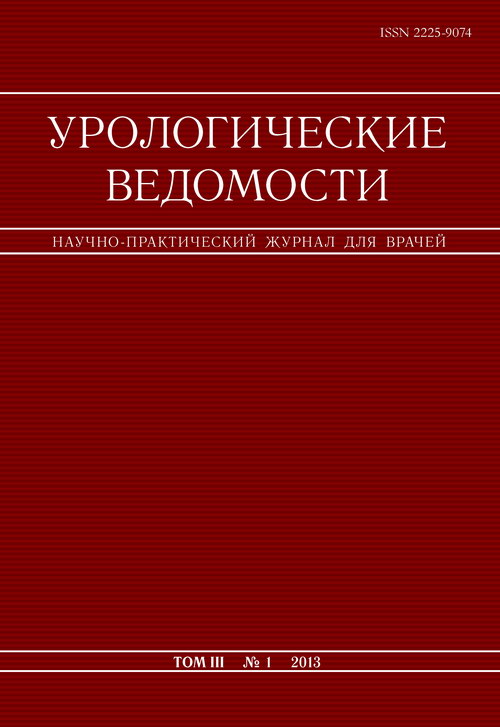Том 3, № 1 (2013)
- Год: 2013
- Выпуск опубликован: 15.03.2013
- Статей: 8
- URL: https://journals.eco-vector.com/uroved/issue/view/142
- DOI: https://doi.org/10.17816/uroved31
Статьи
Новый цистометрический показатель — индексчувствительности мочевого пузыря
Аннотация
Анализ результатов уродинамических исследований 341 больного с гиперактивностью мочевого пузыря показал возможность использования нового уродинамического показателя — индекса чувствительности мочевого пузыря (ИЧ). ИЧ рассчитывается как отношение максимальной емкости мочевого пузыря к объему наполнения мочевого пузыря при первом позыве на мочеиспускание. Значения ИЧ зависят от пола пациента, наличия у него непроизвольных сокращений детрузора и частоты императивных позывов (R2 = 0,03; F = 5,80; p < 0,004). Величина ИЧ отражает скорость нарастания интенсивности позыва на мочеиспускание и может быть дополнительным уродинамическим критерием тяжести гиперактивности мочевого пузыря
Урологические ведомости. 2013;3(1):5-7
 5-7
5-7


Особенности нарушения гемостаза и фибринолиза приразличных клинических формах мочекаменной болезни
Аннотация
Проведена оценка состояния свертывающей системы крови и фибринолитической активности мочи у 436 больных с мочекаменной болезнью и 30 здоровых из контрольной группы. Результаты исследования показали, что у больных с мочекаменной болезнью имеется склонность к гиперкоагуляции и снижению фибринолитической активности мочи, причем выраженность этих нарушений была наибольшая у пациентов с двусторонним нефролитиазом
Урологические ведомости. 2013;3(1):8-10
 8-10
8-10


Метод биологической обратной связи в лечениистрессового недержания мочи у женщин
Аннотация
Изучена эффективность тренировок тазовых мышц в сочетании с биологической обратной связью при лечении 39 женщин со стрессовым недержанием мочи. Продолжительность курса лечения составила 3 месяца. У 11 (28,2 %) женщин после окончания лечения отмечено полное исчезновение симптомов стрессового НМ, а у 20 (51,3 %) — существенное уменьшение их выраженности. Положительный эффект отсутствовал у 8 (20,5 %) больных, у 7 из которых стрессовое НМ было вызвано недостаточностью уретрального сфинктера
Урологические ведомости. 2013;3(1):11-13
 11-13
11-13


Уродинамическая диагностика инфравезикальнойобструкции у мужчин
Аннотация
Проведен анализ результатов исследований «давление/поток», выполненных 39 мужчинам с симптомами нижних мочевых путей. Использование для интерпретации результатов формулы Абрамса–Гриффитса позволило указать на наличие или отсутствие инфравезикальной обструкции у 21 (53,8 %) больного, тогда как у 18 (46,2 %) это сделать не удалось. При включении в традиционную формулу поправки К на нелинейность связи между детрузорным давлением и скоростью потока мочи, величина которой рассчитывается по формуле К = 58,7 – 0,00554 × (Qmax)3 , позволило уменьшить число пациентов в «зоне неопределенности» до 7 (18 %).
Урологические ведомости. 2013;3(1):14-17
 14-17
14-17


Амбулаторный уродинамический мониторинг
Аннотация
В статье показаны история развития и предпосылки к появлению амбулаторного уродинамического мониторинга (АУМ). Подробно описаны показания к проведению, методика выполнения и особенности интерпретации результатов исследования. Представлены результаты применения АУМ в клинической практике и перспективы его использования.
Урологические ведомости. 2013;3(1):18-22
 18-22
18-22


Ошибки диагностики и стадирования ракапредстательной железы
Аннотация
В данном обзоре оцениваются преимущества и недостатки основных методов диагностики и стадирования рака предстательной железы, приводятся сведения о современных высокотехнологичных методах стадирования и номограммах. Рассматриваются причины ошибок, возникающих при диагностике и стадировании рака предстательной железы.
Урологические ведомости. 2013;3(1):23-27
 23-27
23-27


Рак полового члена
Аннотация
Рак полового члена — редко встречающееся новообразование с агрессивным злокачественным потенциалом. Возможность применения органосохраняющего лечения при начальных стадиях болезни диктует необходимость раннего выявления и обследования с целью стадирования опухолевого процесса. В статье представлен обзор литературы, посвященной новообразованиям полового члена, на клиническом примере из собственной практики обсуждены современные подходы к диагностике и лечению больных.
Урологические ведомости. 2013;3(1):28-32
 28-32
28-32


Малоинвазивные методы лечениямочекаменной болезни
Аннотация
В лекции подробно описаны основные малоинвазивные методы лечения мочекаменной болезни — дистанционная ударно-волновая литотрипсия, эндовидеохирургические операции, в том числе перкутанная нефролитотрипсия. Приведены показания и противопоказания, указаны преимущества и недостатки каждого их этих методов. Представлен собственный опыт применения малоинвазивных методов лечения больных с камнями почки, мочеточника и мочевого пузыря.
Урологические ведомости. 2013;3(1):33-38
 33-38
33-38













